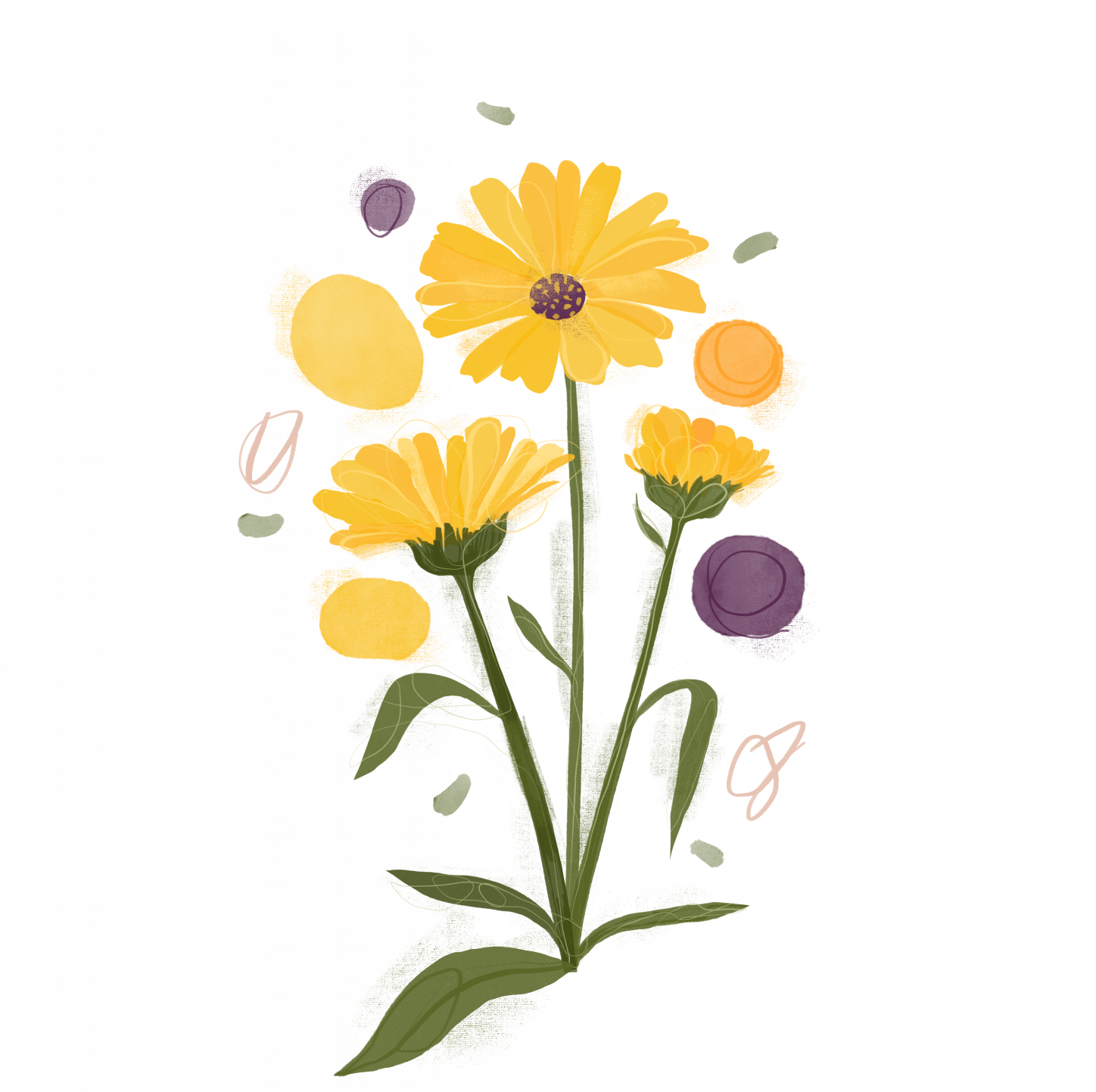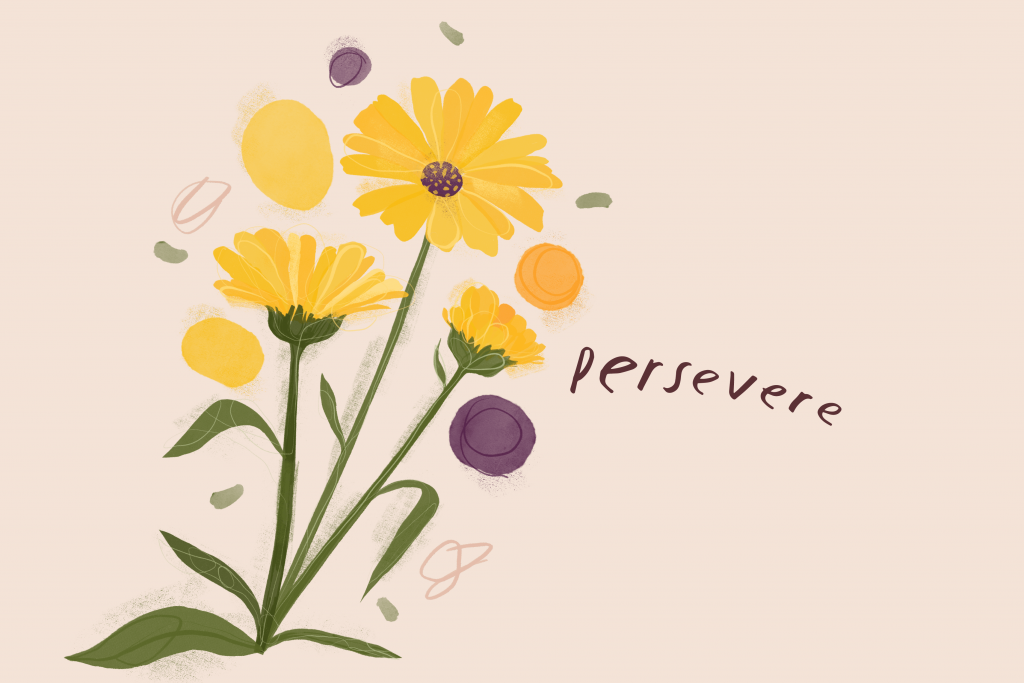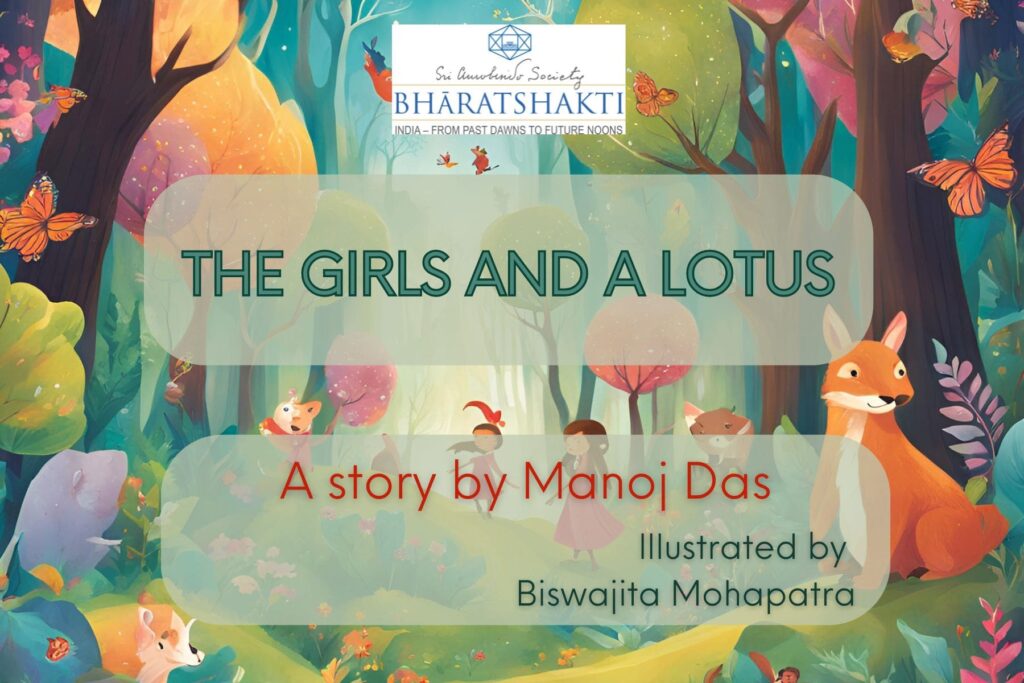Volume II, Issue 6
Author: Sheeba Naaz
Editor’s Note: The author reflects on her patient inner work which helped her experience a deeper harmony, and the endurance it took her to work through the challenges.

Calendula flower (Calendula Officinalis), commonly known as Pot Marigold, is more than a thousand-year-old flower variety. Later the flowers named Tagates Patula and Tagates Erecta also came to be known by the common name marigold (French Marigold and African Marigold, respectively) because of similar looking flowers. But it is important to note that calendula or the pot marigold is a different genus, has a different flower structure, folklore and history.

spiritual significance given by the Mother: Perseverance, the decision to go to the very end.
Known as the “herb of the sun,” calendula is a sacred plant for Hindus in India, its flowers used extensively in various auspicious ceremonies. The flowers have been particularly associated with Lord Ganesha. But due to close similarity with the French and African marigolds, the other two marigold varieties are now more commonly seen in puja and other Hindu rituals and ceremonies.
What’s in a Name?
The scientific name, Calendula, has a Roman history. ‘Calends’ (or Kalends, more precisely) was the first day of each Roman lunar month. The word ‘calendula’, chosen for the plant by Linnaeus in the year 1750, was apparently a diminutive form of the word ‘calends’. As per the Oxford English dictionary, the word calendula is derived from ‘calendulae’, meaning a little calendar, a little clock or little weather.
But why did the Romans choose to name this flower after the first day of the month? It is because these flowers bloomed exactly like the clockwork, blooming especially on the first day of the month. Also, they open their petals around the sunrise and close by the sunset. Linnaeus must have been an ardent gardener to notice this! Nevertheless, the key point here is the clockwork like rhythm of these flowers and their close relation with time and regularity.
No wonder the deeper vibration of the calendula flower which the Mother contacted inwardly is that of Perseverance! A soul-quality that is all about patience and endurance over a long period of time.
Perseverance is patience in action.
~ The Mother, CWM, 14: 162
Life is such that almost all of us face obstacles and hardships at some point or another. This is true of personal and professional life. But when we give ourselves time, and work diligently with patience, wisdom and cheerfulness, we persist and with Divine grace also meet the goals we set for ourselves. Perhaps that’s why Calendula flowers are offered to Lord Ganesha before starting something new, to seek his blessings for the patience and perseverance we will need to work through the obstacles without faltering.
The Mother’s advice that we meditate upon flowers and cultivate a deeper connection with their beauty makes perfect sense because this helps us gradually absorb the deeper vibration and quality that different flowers symbolise and express. For example, an interesting fact about Calendula flowers is that these marigolds are edible unlike the other varieties of marigolds. These herbs are used in medicines and help reduce inflammation and increase clarity. And we would all agree that without clarity, one will not be able to persevere on one’s path.
It is by persevering that one conquers difficulties, not by running away from them. One who perseveres is sure to triumph. Victory goes to the most enduring. Always do your best and the Lord will take care of the results.
(The Mother, CWM, 14: 163)

Harmonising the Inner and Outer
Most success stories – whether in professional or economic or social spheres – are about grit, determination and endurance. Life offers us opportunities and paths – some we choose, and others are chosen for us by other forces. Sometimes we are blessed with right opportunities at the right moment in our life.
But to transform those opportunities into real success requires immense courage, steadfastness and a great deal of perseverance to work our way through difficulties on the way. One needs to have a warrior like attitude to face the challenges of life. This is generally the story of all those who have been trailblazers in any way.
But it is important to understand that through all these life experiences and challenges, our evolutionary progress in life generally happens at two levels. Our ancients spoke of these two evolutionary levels as two different kinds of knowledge. One is at an exoteric level, also known as apara vidya in Indian spiritual tradition; and the other is esoteric knowledge or para vidya.
Exoteric knowledge is the objective knowledge of the outer world and life; Sri Aurobindo speaks of it as knowledge of the Multiplicity. But esoteric knowledge or para vidya is subjective knowledge which leads us to a deeper awareness of Self and opens the door to spiritual experiences. Sri Aurobindo speaks of it is as knowledge of the One.
Also read:
SRI AUROBINDO ON ISHA UPANISHAD – PART 4
Pursuing only the path of exoteric knowledge one may at some point recognise a Divine entity that is outside of self, whereas an exclusive pursuit of the esoteric leads one to discover and connect with the Divine within us. Both types of knowledge are necessary – one may lead us towards our external goal in life while the other will bring us closer to our inner truth.
Even though the two may seem quite opposed to each other, they are closely linked. Without the esoteric knowledge, the exoteric is like a mirage or an illusion that is somewhat unreal. No wonder many people who attain great heights of success in corporate or professional lives end up with a sense of void and meaninglessness. That is because of the wide disconnect between their external and internal worlds.
Persevere for Equanimity and Harmony
While speaking of the spiritual significance of flowers, the Mother often reminds of a close relation between the external and internal worlds, which is the secret towards complete satisfaction and harmony. When contemplating upon perseverance or any of the other 12 attributes or soul-qualities we must cultivate as part of our inner journey to become fit instruments for the Mother’s divine work in the world, we can’t ignore to consider this relation between the external and internal aspects.
This was pointed to me by my yogasana teacher many years ago. It so happened that once my husband, after promising me that I would accompany him on his business trip to Belgium, couldn’t keep his promise because of some change of plans. And I was really disappointed and brooded over this for a few days. My then yoga teacher noticed my mood and asked me if something was the matter with me. Reluctantly, I told him the reason. He smiled and recited a shloka from Bhagavad Gita.
योगस्थः कुरु कर्माणि संगं त्यक्त्वा धनंजय ।
सिद्ध्यसिद्ध्योः समो भूत्वा समत्वं योग उच्यते ॥2.48॥
Fixed in Yoga do thy actions, having abandoned attachment, having become equal in failure and success;
for it is equality that is meant by Yoga. (Translation by Sri Aurobindo)
At that point of time, I practiced yogasana only for physical reasons and my goal was one day to become a yoga teacher. Little did I realize that the entire practice of yogasana is to reach a place of samatvam or inner equilibrium, also known as equanimity. This one shloka made me perceive my goal with perfect clarity.
I was a highly sensitive and an emotionally challenged person, easily disturbed and anxious most of the time. Once the clarity came and I realized my inner, truer goal in life, things started to change. My whole journey of yoga became my practice to gain emotional stability. And believe me, it has been a very hard journey. To persevere in the external world is easier when compared to persevering in the internal world. It requires changing our entire habitual pattern of belief system and it is never instantaneous.
The path of this internal journey was new and alien. But once I stepped in, patience and time were the only two attributes that gave me strength to persevere. To reach a place of emotional stability is not easy and it took me years to understand through deep study of books, attending satsangs and learning from different mentors, philosophers and teachers.
Many years later I not only became a yogasana teacher but also reached a state of mental equilibrium, which has brought deep joy and harmony to my existence.
Coda
Funny that as I write this, my daughter’s wedding just got over in Vancouver, British Columbia in Canada. I couldn’t attend the wedding because of delay in my visa formalities due to pandemic. Many friends felt uncomfortable in calling me or writing to me with their good wishes, thinking that I might be devastated and sad due to not being there for the wedding.
But the fact is that what I experienced during those few days around the wedding was a great sense of joy; I didn’t feel disappointed or sad. I even felt that it all happened this way for some greater good. I can humbly say that this experience has made me realize that all my hard work and perseverance in the practice of yoga has paid me off with good result!
What you are not able to do today, you will achieve tomorrow. Persevere and you shall conquer. (CWM, 14: 163)

~ Graphic design: Shahla Sayeed



